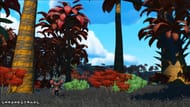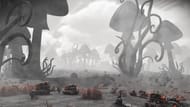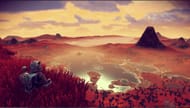Out of 18 quintillion planets located all across the No Man's Sky universe, players often come across some anomalies that are both unique and weird in their own way. It can be the planet itself, the flora, or even the animals in its atmosphere.
There is always something magical about the world of No Man's Sky, and it never seems to end. The game lets you discover as many galaxies as you want by following a quest path or by ultimately going off the charts on your own. During the journey, you will experience some unexpected entities in space.
The following article lists five unique planets you might encounter during your No Man's Sky journey, along with endless space.
Looking for Crossword hints & solutions? Check out latest NYT Mini Crossword Answers, LA Times Crossword Answers, and Atlantic Crossword Answers
Pillared and four other unique planet types that can be found in No Man's Sky
1) Temporary planet

Temporary planets are one of the rarest planet types found in No Man's Sky, which can be identified from space by their small hexagonal and square shapes on the surface. This planet type falls under Exotic biomes, added with the Atlas Rises update.
The usual settlements and structures such as trading posts, observatories, depots, drop pods, plaques, monoliths, and portals are absent here. These planets usually do not have any storms, heat waves, toxicity, or radiation in the atmosphere.
2) Mega Exotic planets

Mega Exotic planets were introduced with the NEXT update, consisting of larger versions of everything found on normal planets. In some cases, this can consist of trees, pillars, rocks, and even lifeforms. While these types of biomes might seem dead from space, they consist of a specific type of atmosphere.
You can look for red, green, and blue star systems to find these types of biomes. Mega Exotic planets don't all necessarily include huge-sized structures since a few of them can be similar to Lush biomes with grass and trees.
3) Planetary anomaly

A Planetary anomaly is a planet type that can be found with all sorts of flora, fauna, and weather conditions. There are often cases when you can come across grey-scaled planets, and in some cases, you will find floating balls and cubes that you can tame and ride.
The most common types of plants on these planets are the ones that usually emit a ray of light from them. Other than that, you might also come across hazardous weather conditions. Planetary anomaly is one of the most unique types of planets found in the game, where you will also have the chance to find a rare material called Cymatygen.
4) Bountiful planets

Bountiful planets fall under the Lush biome category, which is usually ideal for base-building. They come with limited to no sentinel activities, ideal flora and fauna, alongside random weather conditions. This planet type is considered pretty close to paradise planets, with the only difference being relatively rarer.
Resources such as Paraffinium, Star Bulb, and Nitrogen are common among these biomes. You can warp on yellow stars alongside normal and harsh galaxies to increase your chances of encountering a Bountiful planet.
5) Pillared planets

Yet another planet type found within the Exotic category, Pillared planets are considered the rarest planets in the game. As the name suggests, the surface of these planets are, indeed, filled with pillars. These pillars can be further mined and scanned.
You have the best chance of finding Pillared planets within red-starred galaxies, as Exotic biomes are common in those.
Are you stuck on today's Wordle? Our Wordle Solver will help you find the answer.
